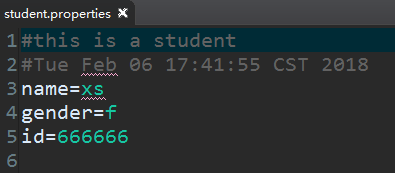Properties:可以持久化的映射,规定键和值的类型是String。
Properties对象必须放到.properties文件中,其中properties文件默认为西欧编码,也因此不存储中文。
1.写properties文件
1 import java.io.FileOutputStream; 2 import java.util.Properties; 3 4 public class PropertiesDemo { 5 public static void main(String[] args) throws Exception { 6 // 创建一个properties对象 7 Properties prop = new Properties(); 8 // 添加键值对:键和值的类型都是String 9 prop.setProperty("name", "xs"); 10 prop.setProperty("id", "666666"); 11 prop.setProperty("gender", "f"); 12 // 持久化 13 // Properties对象在序列化的时候必须放到properties文件中 14 // 第二个参数表示向properties文件中添加注释描述这个properties文件的作用 15 prop.store(new FileOutputStream("student.properties"), "this is a student"); 16 } 17 }
student.properties:

2.读properties文件
1 import java.io.FileInputStream; 2 import java.util.Properties; 3 public class PropertiesDemo2 { 4 public static void main(String[] args) throws Exception { 5 Properties prop = new Properties(); 6 // 读取properties文件 7 prop.load(new FileInputStream("p.properties")); 8 // 根据键获取值:如果键不存在,则返回一个null 9 // 也可以指定默认值(如果没有对应的键,则返回默认值) 10 System.out.println(prop.getProperty("id")); 11 System.out.println(prop.getProperty("x")); 12 System.out.println(prop.getProperty("xxx", "x")); 13 } 14 }
结果:

3.properties的用处

path=D:\a.txt ----->进行更改---> path=D:\b.txt
1 import java.io.FileInputStream; 2 import java.util.Properties; 3 4 public class PropertiesDemo3 { 5 public static void main(String[] args) throws Exception { 6 // 创建properties对象 7 Properties prop = new Properties(); 8 while (true) { 9 // 加载properties文件 10 prop.load(new FileInputStream("config.properties")); 11 // 读取文件 12 FileInputStream fin = new FileInputStream(prop.getProperty("path")); 13 byte[] bs = new byte[10]; 14 int len = -1; 15 while ((len = fin.read(bs)) != -1) { 16 System.out.println(new String(bs, 0, len)); 17 } 18 fin.close(); 19 Thread.sleep(3000); 20 } 21 } 22 }
结果:

